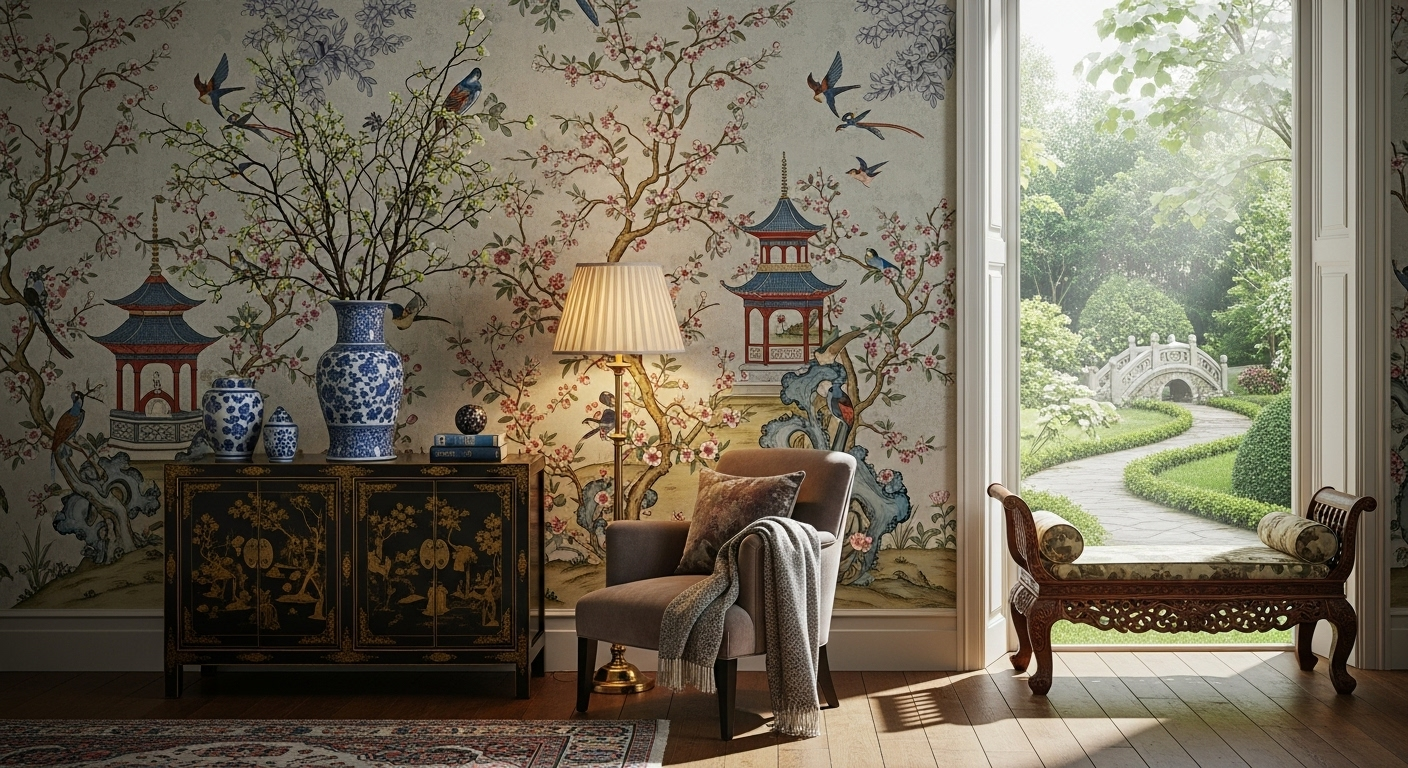The Art of Chinoiserie: Eastern Elegance in Western Homes
Imagine stepping into a room where delicate hand-painted wallpapers transport you to an exotic garden, where lacquered furniture gleams with an otherworldly sheen, and where intricate porcelain vases tell stories of distant lands. This is the world of Chinoiserie, a design style that has captivated Western imaginations for centuries and is experiencing a vibrant revival in today's eclectic interiors.

The style reached its zenith in the 18th century, adorning the palaces of European royalty and the manor houses of the aristocracy. Chinoiserie represented more than just a design choice; it was a statement of sophistication, worldliness, and exotic luxury.
Key Elements of Chinoiserie Design
At the heart of Chinoiserie lies a celebration of nature and craftsmanship. Stylized depictions of flora and fauna, particularly birds and flowers, are quintessential elements. Pagodas, bridges, and fanciful landscapes populate Chinoiserie scenes, often rendered in vibrant blues, greens, and reds against white backgrounds.
Lacquerwork, a technique perfected in Asia, became a hallmark of Chinoiserie furniture. The glossy, often black surfaces provided a perfect canvas for intricate gilt decorations. Bamboo, both real and faux, found its way into furniture designs, adding an exotic touch to Western interiors.
The Modern Resurgence of Chinoiserie
In recent years, Chinoiserie has experienced a remarkable revival, resonating with contemporary tastes for maximalism and global influences. Today’s designers are reinterpreting the style, infusing it with modern sensibilities while honoring its rich history.
One of the most striking ways to incorporate Chinoiserie is through wallpaper. Modern printing techniques have made it possible to create stunning panoramic murals that transform entire rooms into lush, fantastical landscapes. These wallpapers often feature a mix of traditional Chinoiserie motifs with contemporary color palettes, bridging the gap between past and present.
Chinoiserie in Everyday Spaces
While Chinoiserie might seem intimidating, it’s surprisingly versatile and can be incorporated into various design schemes. A single statement piece, such as a lacquered cabinet or a pair of foo dog lamps, can add a touch of Eastern elegance to any room.
For those hesitant to commit to full-scale Chinoiserie, accessories offer an accessible entry point. Ginger jars, blue and white porcelain, and silk throw pillows with Chinoiserie motifs can introduce the style subtly. Even small touches like Chinoiserie-inspired drawer pulls or a painted folding screen can evoke the essence of the style without overwhelming a space.
The Art of Balance: Mixing Chinoiserie with Other Styles
One of the most exciting aspects of contemporary Chinoiserie is its ability to blend seamlessly with other design styles. The key is in creating a harmonious balance. Paired with mid-century modern pieces, Chinoiserie adds a layer of history and exoticism. In a minimalist setting, a single Chinoiserie element can serve as a striking focal point.
Designers are also exploring unexpected color combinations, moving beyond the traditional blue and white to incorporate bold hues like emerald green, coral, and deep purple. This fresh approach allows Chinoiserie to feel at home in even the most contemporary interiors.
Chinoiserie in the Garden: Extending Eastern Charm Outdoors
The influence of Chinoiserie extends beyond interior spaces into garden design. Pagodas, moon gates, and bridges have long been staples of Chinese-inspired gardens. Today, these elements are being reinterpreted for modern outdoor spaces.
A Chinoiserie-inspired garden might feature a lacquered red garden bench, blue and white planters, or a whimsical pavilion. Even small balconies or patios can embrace the style with carefully chosen accessories like lanterns or a folding screen used as a backdrop for container plants.
The Ethical Considerations of Chinoiserie
As we embrace Chinoiserie in the 21st century, it’s important to approach the style with cultural sensitivity. Modern interpretations of Chinoiserie should strive to honor and accurately represent Chinese culture rather than perpetuating stereotypes or appropriating without understanding.
Many contemporary designers are collaborating with Chinese artisans and studying traditional techniques to create authentic, respectful interpretations of Chinoiserie. This approach not only results in more genuine designs but also supports and celebrates the living traditions that inspired the style.
Chinoiserie: A Timeless Fusion of Fantasy and Craftsmanship
Chinoiserie’s enduring appeal lies in its ability to transport us to a world of fantasy and beauty. It’s a style that invites dreaming, that celebrates the art of storytelling through design. As we continue to navigate an increasingly interconnected world, Chinoiserie serves as a beautiful reminder of the rich cultural exchanges that have shaped our aesthetic sensibilities.
Whether expressed through a grand hand-painted mural or a simple porcelain vase, Chinoiserie continues to enchant and inspire. It’s a testament to the enduring power of cultural fusion in design, inviting us to create spaces that are not just visually stunning, but rich in history and imagination.





